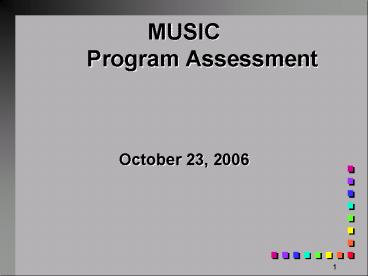MUSIC Program Assessment - PowerPoint PPT Presentation
1 / 22
Title:
MUSIC Program Assessment
Description:
(Vocal Music) Kindergarten- 25 minutes per week (Full Day K 50 minutes per week) ... (Vocal Music) Grades 6-8 18 days per year (60 minute class period) ... – PowerPoint PPT presentation
Number of Views:30
Avg rating:3.0/5.0
Title: MUSIC Program Assessment
1
MUSIC Program Assessment
- October 23, 2006
2
Committee Members
- Patricia Barker
- Rowland Bennett
- Denise Giorello-Moczulski
- Jim Imhoff
- Jim Memoli
- Lori Mirabel
- Vern Miller
- Peg Roberts
3
Committee Members
- Nicholas Santoro
- Christine Steck
- Mary Beth Sweet
- Susan Weitzer
- Ebony Wiggins
4
Mission Statement
- The mission of the Music Program is to provide
all students a sequential music experience, which
fosters perceptual awareness, critical thinking,
and creativity through the process of creating
and performing music, and at the same time
promotes an appreciation of music and its role in
the world.
5
Primary Program Goals
- Students will
- Acquire knowledge and skills that contribute to
aesthetic awareness of music. - Use the skills, tools, media, methods, and
technologies appropriate to the creation and
performance of music. - Demonstrate an understanding of the elements and
principles of music. - Develop a process by which they will observe,
describe, analyze, interpret, and evaluate
artistic expression and quality. - Understand and analyze the role, development, and
continuing influence of music in relation to
world cultures, history, and society.
6
Program StructureKindergarten - Grade 12(Vocal
Music)
- Kindergarten- 25 minutes per week
- (Full Day K 50 minutes per week)
- Grades 1-5 - 50 minutes per week
7
Program StructureKindergarten - Grade 12(Vocal
Music)
- Grades 6-8 18 days per year (60 minute class
period) - Grades 9-12 Elective Offerings (classes meet
212-215 minutes per week)
8
Program StructureKindergarten - Grade
12(Instrumental Music)
- Begins in Grade 5 30 minute lesson per week, 25
minute rehearsal per week - Grades 6-8 One rotating group lesson per week
(60 minutes), two 25 minute rehearsals per week - Grades 9-12 Elective offerings (classes meet
212-215 minutes per week)
9
Methods of Assessment and Results
- Quantitative Data
- Grades 2, 4, and 7 District Wide Music Assessment
- Grades 4-12 Instrumental Music Trends
- Columbia High School Music Course Enrollment
10
Methods of Assessment and ResultsGrades 2, 4, 7
Music Assessment
- The data indicate the program is achieving it
goals for the majority of students in these
grades. - In grade 7 there is a decrease in the percentage
of students achieving Goal 2A (singing alone and
with others)
11
Methods of Assessment and ResultsInstrumental
Music Trends
- There is very little difference in the total
number of students beginning an instrument since
the program was moved from grade 4 to grade 5. - The number of students beginning a string
instrument was lower the first year the program
began in grade 5.
12
Methods of Assessment and ResultsInstrumental
Music Trends
- The percentage of band students continuing from
grade 5 to grade 6 dropped when beginning
instrumental instruction was moved from grade 4
to grade 5. - The percentage of string students remained the
same.
13
Methods of Assessment and ResultsCHS Music
Course Enrolment 2005-2006
- 382 students (20 of the school population)
occupied 432 seats in the 13 music courses
offered at CHS. - Music courses are accessible to all students.
14
Methods of Assessment and Results
- Qualitative Data
- SURVEYS
- Grades 4 and 6 Parents
- Grades K-12 Music Teachers
- Grades 4, 6, and 12 Students
15
Parent SurveyGrades 4 and 6
- 98 value music education.
- 86 attend music performances as a family.
- 98 indicate children create, play, sing or
listen to music for enjoyment at home. - 70 indicate satisfaction with the music program.
- 77 indicate their children enjoy the music
program.
16
Music Teacher Survey Grades K-12
- Familiar with State Standards
- Curriculum appropriate and reflective of what
they teach - Meeting Music Program Goals
- Satisfaction with the Music Program
- Concerns about support from the administration
and colleagues - Concerns on the scheduling of the elementary and
middle school instrumental and choral programs
17
Student SurveysGrades 4 and 6
- 67 Value art education
- 93 Enjoy creating, singing, playing, and
listening to music for enjoyment - 85 are satisfied with in-school music classes
- 91 of grade 4 students would consider learning
to play an instrument in grade 5
18
Student Survey Grades 12
- 73 cite interest/talent and family influence as
reasons for studying music - 73 are satisfied with in-school music classes
- 45 have a better appreciation of music because
of their district music classes
19
Recommendations
- Increase Communication
- between the music department and the community
regarding curricular offerings, and
lesson/performance scheduling and - between the music department and district and
building level administration and staff regarding
the value of the music program and its optimum
program operation
20
Recommendations
- Standardize the delivery of the 4th and 5th grade
choruses and the 5th grade instrumental program
(scheduling, facilities). - Improve articulation and integration between
elementary/middle and middle/high school to
maximize participation.
21
Recommendations
- Examine the general, choral, and instrumental
middle school music program to insure
consistency. - Realign the 9-12 music curriculum to the newly
adopted New Jersey Core Curriculum Content
Standards where necessary. - Continue to implement district assessments at
various grade levels in order to determine
program effectiveness.
22
Music Program Assessment
- October 23, 2006































